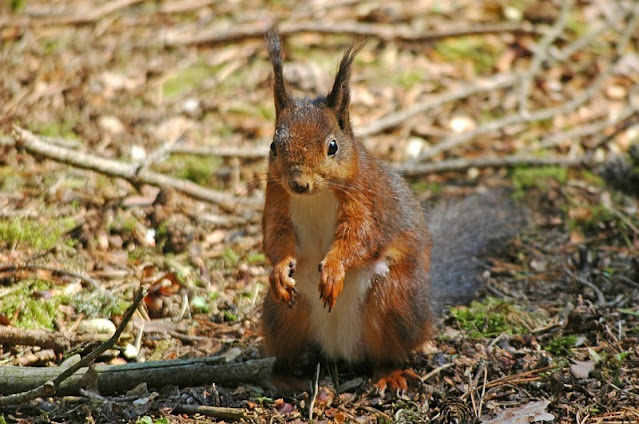When I first read about
this, I had rather amusing images in my head of male Grey Squirrels scampering
around in the trees wearing condoms
But, no, the plan is apparently much more serious than that.
A proposal to use oral contraceptives to control the population of Grey Squirrels in the UK is making good progress and could soon be put to the test in field trials according to Government scientists.
The mass birth control plan involves luring Grey Squirrels into feeding boxes only they can access. Inside those boxes, pots containing hazelnut spread will be spiked with contraceptives.
It is claimed that the project could help eradicate the Grey Squirrel in the UK without killing them and thereby protect and encourage the increase of the currently declining Red Squirrel and reduce the significant damage that Grey Squirrels do to woodland ecosystems.
The Government scientists leading the research say the contraceptive, which makes both male and female Grey Squirrels infertile, should be ready to deploy in the wild within 2 years.
Grey Squirrels were first introduced to the UK from North America in the late 19th century. They have flourished in the UK and there are estimated to be 2.7 million animals now here.
Grey Squirrels have driven the UK's native Red Squirrel to extinction across much of the country. There are thought to be just 160,000 Red Squirrels left in the UK with only 15,000 remaining in England. Grey Squirrels are significantly larger and stronger than Red Squirrels and out-compete them for food. In addition, they carry a squirrel pox virus that is deadly to Red Squirrels but to which they are immune.
Grey Squirrels also damage UK woodlands by stripping bark from trees to get at the nutritious sap beneath. They target young trees, typically 10 to 50 years old, and favour broadleaf species including oak, beech, sweet chestnut and sycamore. Trees are killed or damaged leaving scarring that allows an entry point for other tree pests and diseases which can stunt their growth.
The traditional way of managing the Grey Squirrel population has been to cull them. However, Grey Squirrels breed rapidly and populations can recover quickly and a century of culling programmes has failed to reduce the population.
The broadcaster and naturalist Chris Packham believes a species-specific oral contraceptive could be a "dream ticket" if it proves to be economically viable and practical. He describes the project as "non-violent direct action" to control "a widespread and extremely numerous invasive animal" and suggests an effort should also be made to encourage Pine Martens, Goshawks and other predators of Grey Squirrels back into their previous ranges across the UK.
I do like seeing lethal controls of animals, not least when invasive species have been introduced by humans with little understanding of their impact, so a non-lethal means of reducing the Grey Squirrel population to address the undoubted problems that they have caused, and continue to cause, has to be welcomed.
Here are some of my photos of Grey Squirrels and Red Squirrels. It is fairly easy to spot the difference .... one is grey and the other is red 😀
💚🦆 🦉🦋🐝🦊🦡🌼 🌳💚
Stay safe, stay well, stay strong, stay connected with nature










No comments:
Post a Comment
If you feel like commenting on my blog, you can contact me by completing the comment form below. I will respond to all comments and enquiries and constructive criticism will always be welcomed.